Braised Beef Cheeks
Beef cheeks are underrated but have a culinary magic that turns cheap beef cuts into delicious and tender bites.
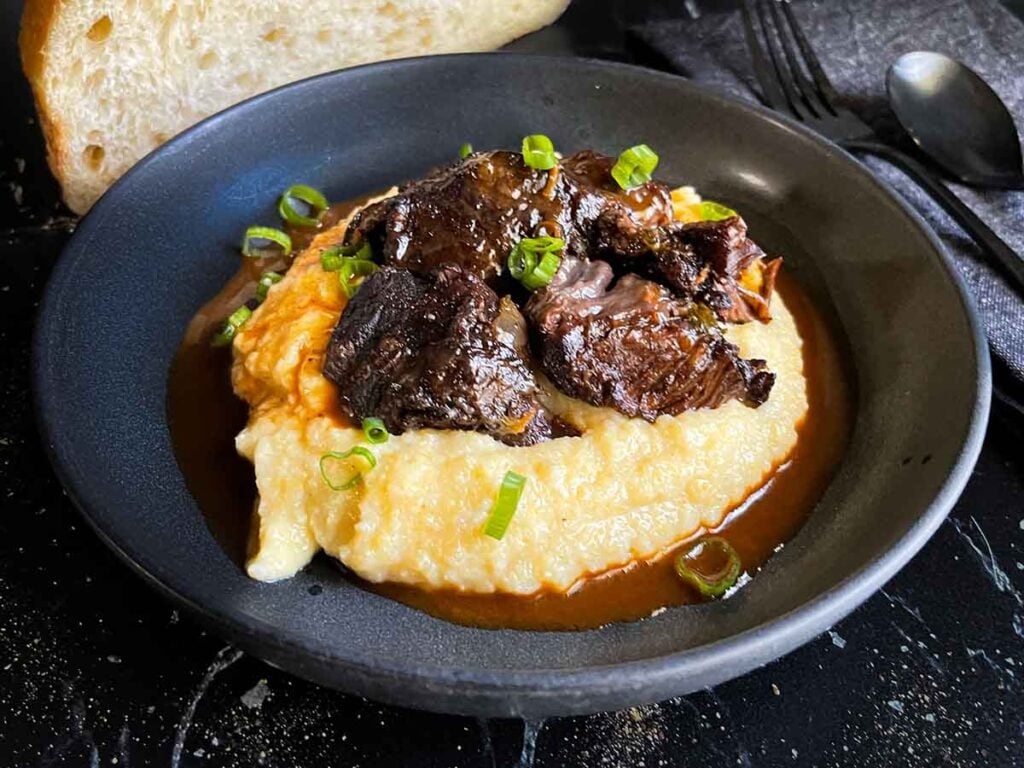
Why You Will Love This Recipe
Beef cheeks are delicious and tender with rich marbling, deep flavors, and a melt-in-your-mouth texture that is delightful.
When these tasty pieces are cooked perfectly, magic happens, creating a dish that represents ultimate comfort and elegance.
Beef cheeks are inexpensive and great for people who love food but are on a budget. They are a hidden treasure.
While other premium cuts may command hefty price tags, beef cheeks offer an economical alternative without compromising taste or quality.
Furthermore, their tough and sinewy nature lends itself perfectly to the slow, gentle cooking process.
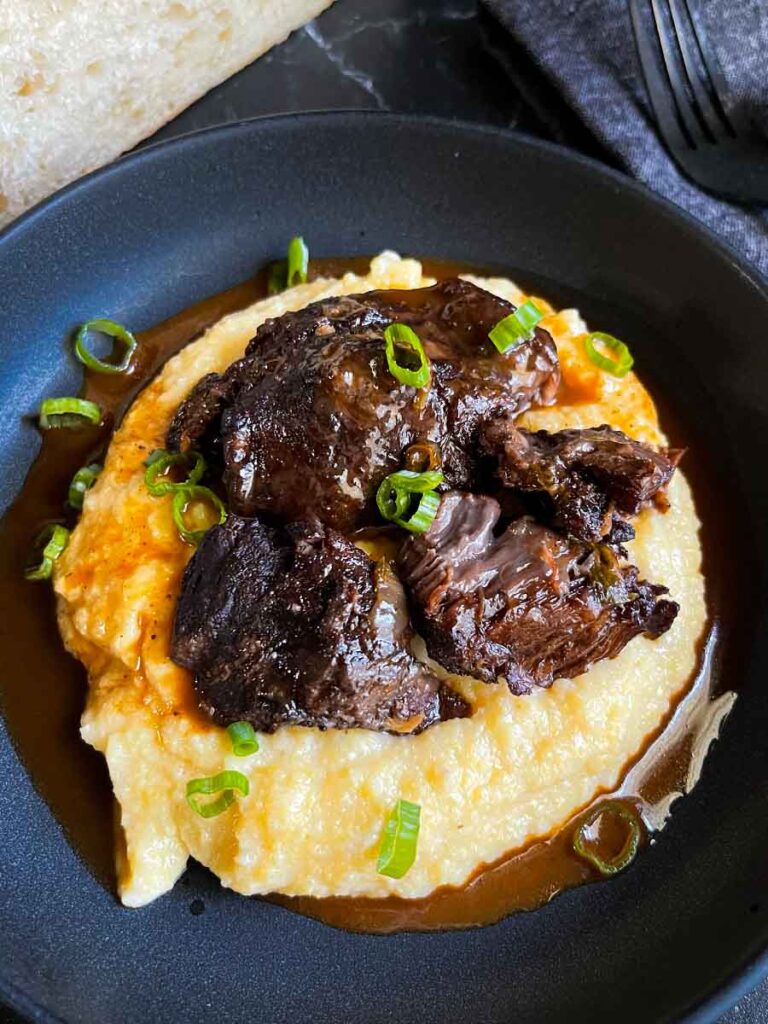
Cooking beef cheeks low and slow makes them incredibly tender. The longer they cook, the better the flavors get, creating a comforting and satisfying dish.
Even with simple and affordable ingredients, slow cooked beef cheeks can be transformed into a culinary masterpiece. Their humble origin achieves sublime perfection.
I would serve these with some amazing creamy polenta (see pictures), but there are other options as well.
This dish pairs well with an easy mashed potatoes, potatoes au gratin, basmati rice risotto, or a loaded cauliflower mash.
Ingredients Needed
While we don’t see this specialty cut in our local grocery store, we do find them at Sam’s and Costco on a regular basis. A local butcher shop would have this tough cut.
Other than this, all the other ingredients for this dish are readily available.
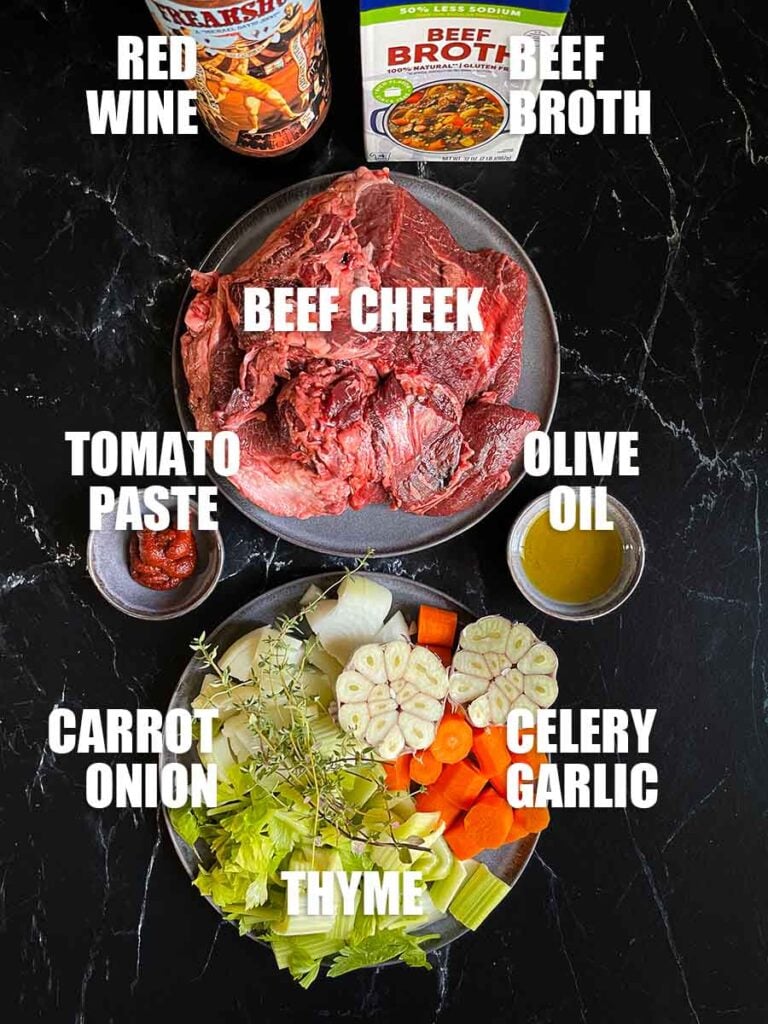
Beef cheeks: The star of the dish. Rich in flavor, they become melt-in-your-mouth when slow-cooked.
Carrots, Celery, Onion: Carrots add subtle sweetness, celery brings a refreshing herbal note, and onions provide a savory foundation.
Garlic: Halved garlic bulbs infuse a distinct pungency into the dish, adding depth and complexity.
Thyme: Earthy and slightly floral, it contributes an herbaceous quality to complement the richness of the beef.
Tomato Paste: Adds acidity, richness, and a touch of sweetness, enhancing the umami flavors.
Red Wine: Brings depth, complexity, and subtle fruity notes, elevating the overall taste profile.
Beef Stock: Provides a savory base, intensifying the meaty flavors and creating a luscious gravy.
Kosher Salt and Black Pepper: Simple seasonings that enhance the natural flavors of the beef and other ingredients, ensuring a well-balanced dish.
These ingredients work together harmoniously, each bringing its distinctiveness to create a remarkable and satisfying dish of braised beef cheeks.
How To Make Braised Beef Cheeks
Using a sharp knife, trim any excess silver skin or connective tissue from the beef cheeks. Season well with kosher salt and black pepper.
Place a Dutch oven or large pot over medium-high heat and add 1 tbsp of olive oil.
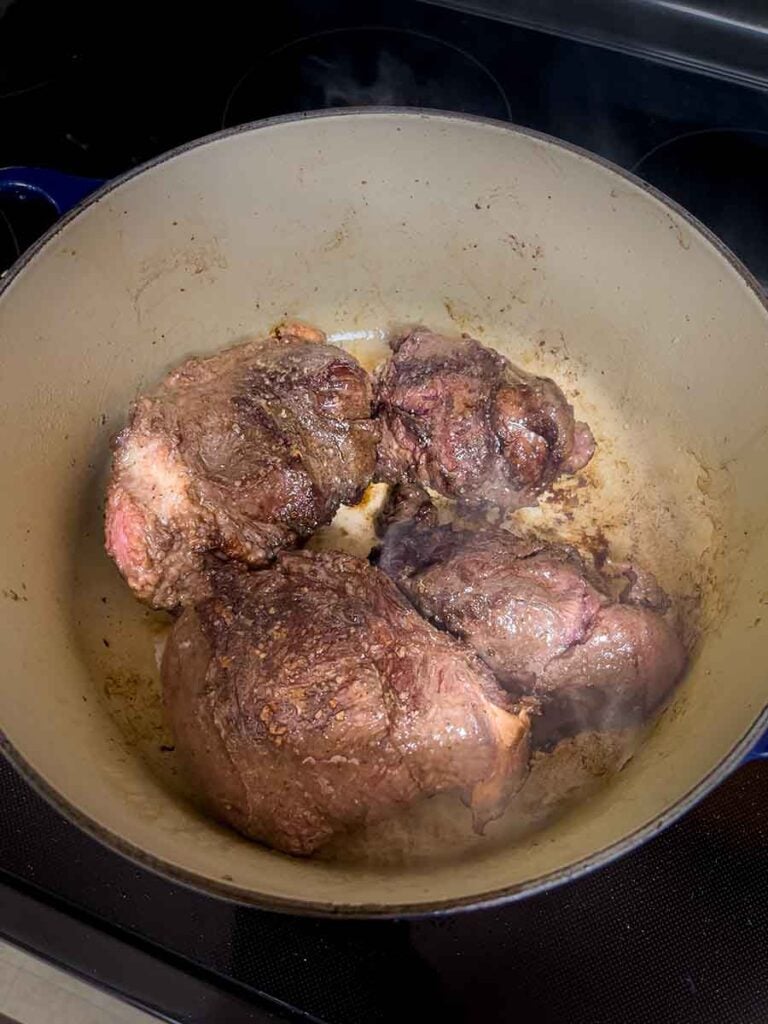
Once heated, sear the beef cheeks on all sides until browned, then remove and set them aside.
Add 1 tbsp of olive oil back to the pot, and then add the carrots, celery, and onion.
Decrease the heat to medium heat. Cook for 5 minutes, stirring occasionally.
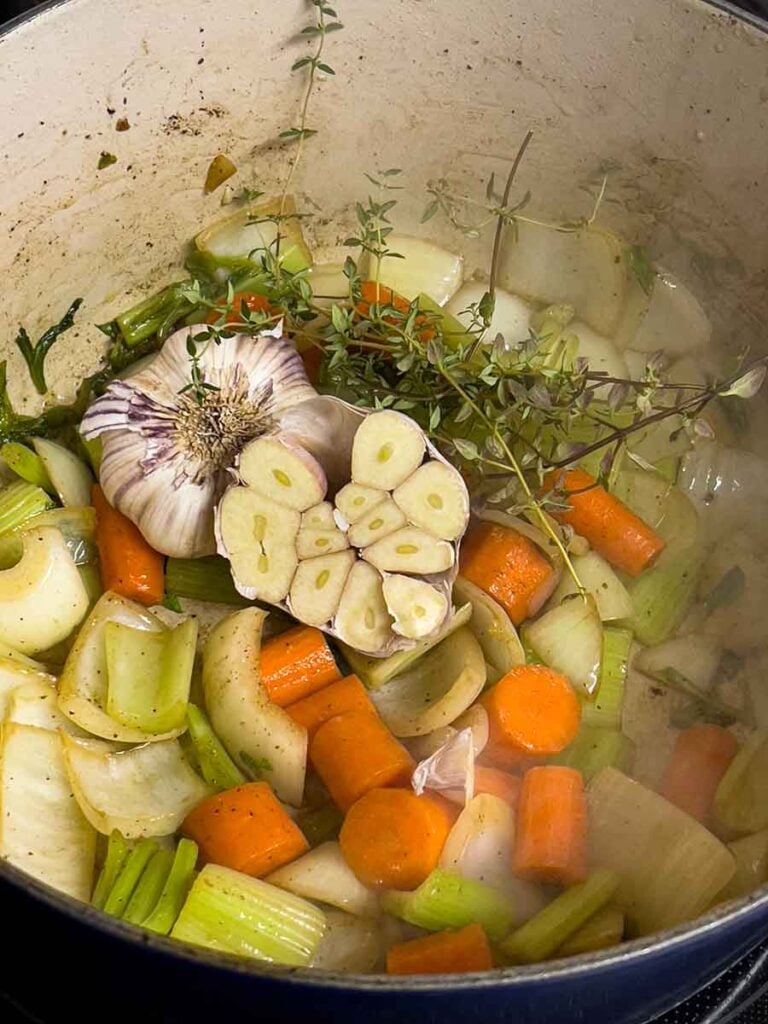
Add the garlic and thyme sprigs, and cook until fragrant.
Stir in the tomato paste and cook for another minute, ensuring the vegetables are coated.
Pour in the red wine and cook for about two minutes to cook out the alcohol. Make sure to scrape the browned bits off the bottom of the pot. That’s good stuff!
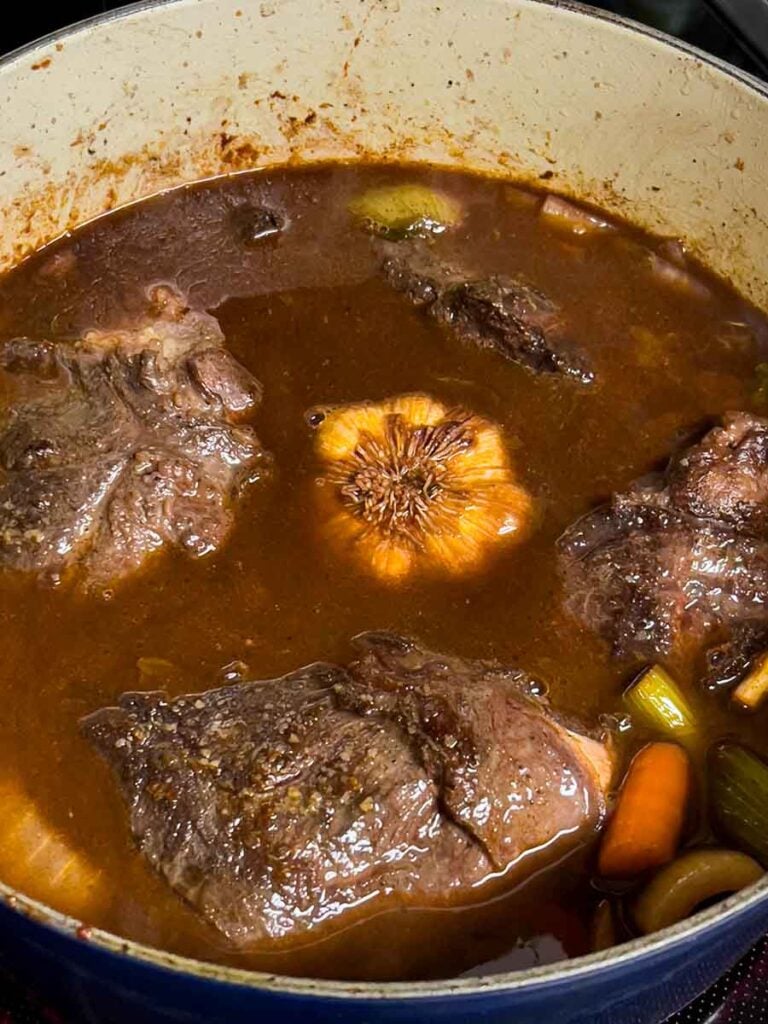
Add the beef stock and the beef cheeks, and reduce the heat to a simmer.
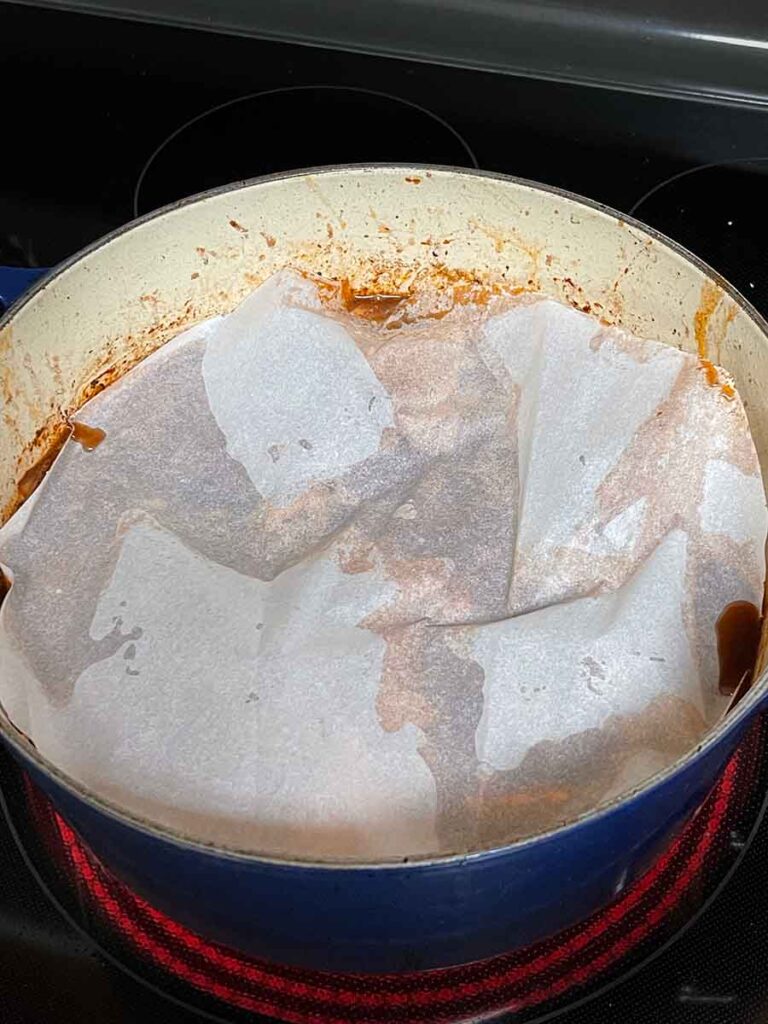
Optionally, cover the contents of the pot with a cartouche (parchment paper cut to fit the pot)
pro tip
A cartouche is a simple but effective cooking technique to cover a dish’s surface during slow cooking or braising. In the context of braised beef cheeks, a cartouche serves a few purposes:
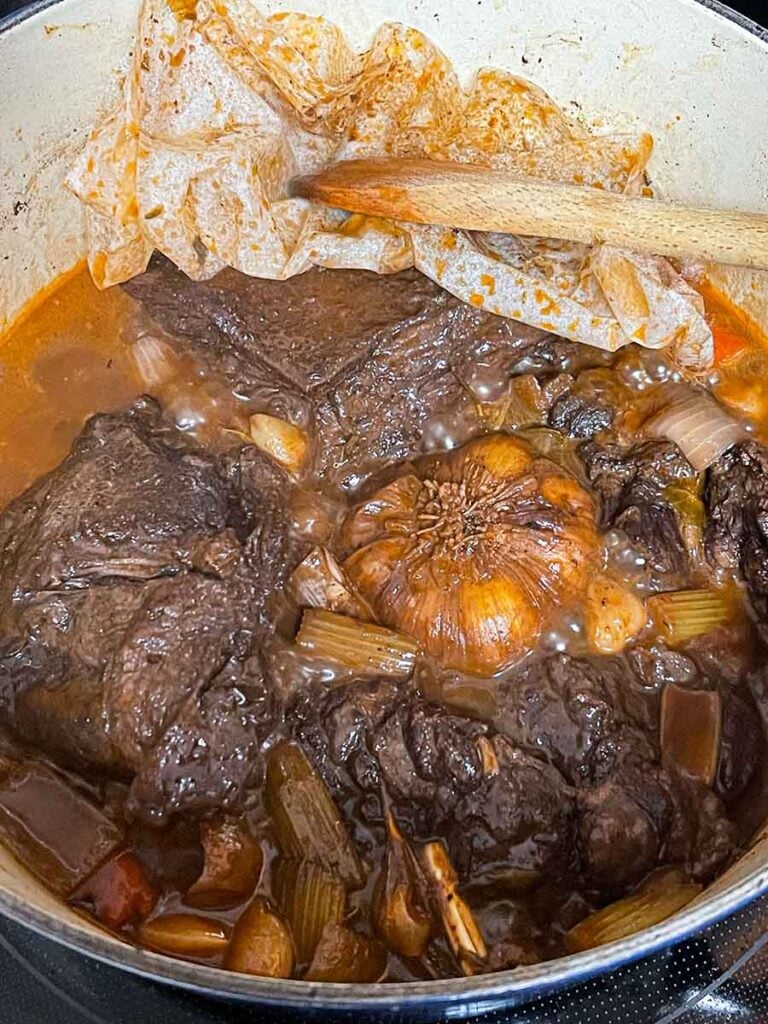
Let it simmer, covered, for approximately 2 hours until the beef cheeks are tender.
Once the beef cheeks are tender and you can cut them with a spoon, remove them from the pot and set them aside.
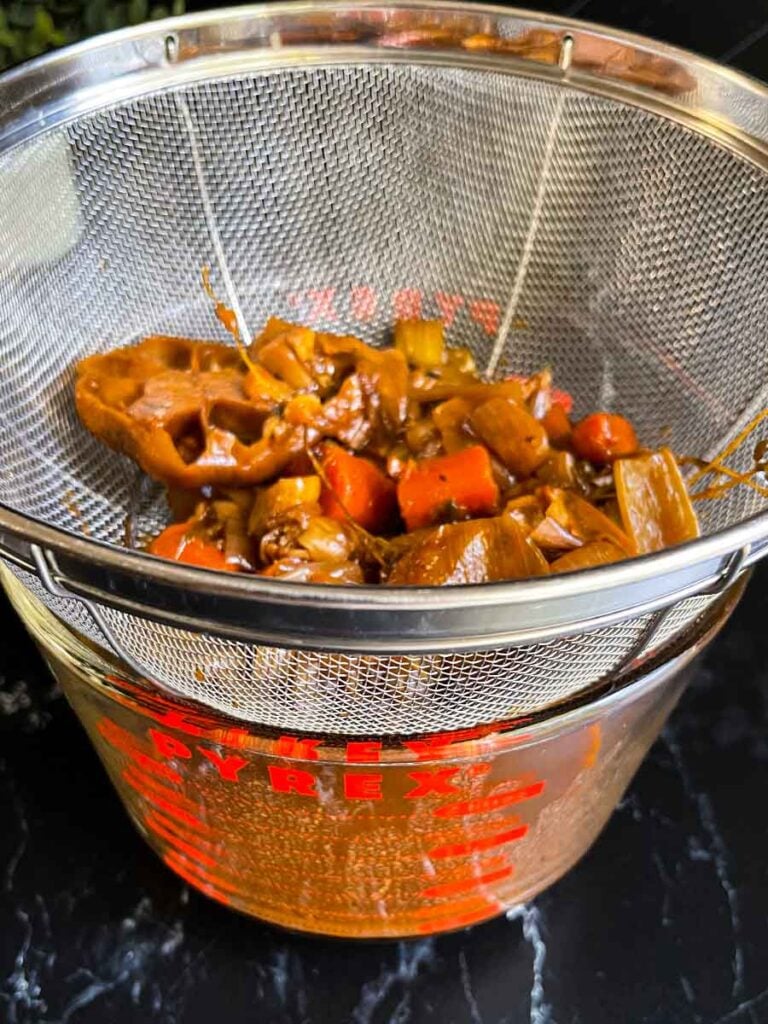
Strain the remaining liquid, discarding the cooked vegetables.
Serve the braised beef cheeks on a plate or shallow bowl and spoon the gravy over them. Optionally garnish with some chopped parsley or green onion.
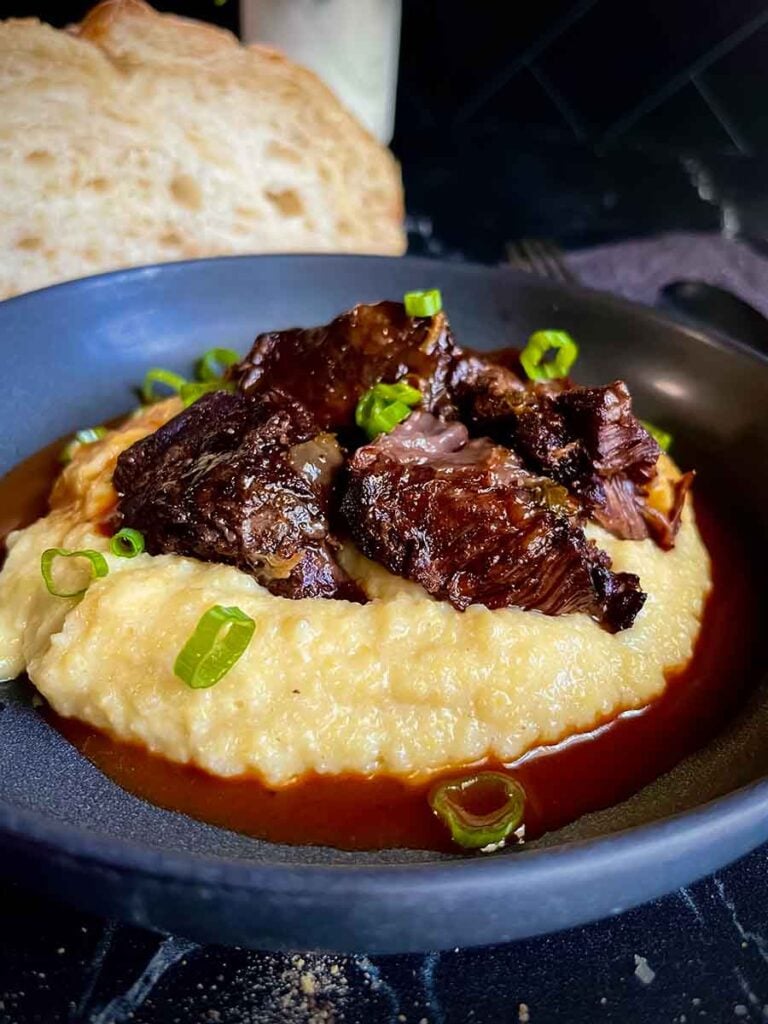
Pair them with your favorite sides ( you have to try our creamy polenta with this!) and enjoy the succulent and flavorful dish. Polenta or mashed potatoes would be perfect with this decadent dish.
Tips And Variations
Patience is key: Braising beef cheeks requires a slow and gentle cooking process. Be patient and allow the cheeks to simmer on low heat for the suggested time. This will ensure that they become tender and develop rich flavors.
Season generously: Season the beef cheeks before searing well with kosher salt and black pepper. The seasoning helps to enhance the natural flavors of the meat and adds depth to the dish. Don’t be afraid to be generous with the seasoning, as the flavors will mellow during the long cooking process.
Let it rest and skim the fat: After braising, allow the cooked beef cheeks to rest for a few minutes before serving. This allows the meat to relax and the flavors to settle. Once you strain the braising liquid, let it cool slightly and skim off any excess fat that rises to the surface. This step will help ensure a cleaner and more refined final sauce.
Asian-inspired Braised Beef Cheeks: Instead of red wine, use a combination of soy sauce, mirin, and beef broth as the braising liquid. Add Asian aromatics such as ginger, star anise, and Chinese five-spice powder to infuse the dish with a distinctively Asian flavor profile.
Spicy Braised Beef Cheeks: Create a spicy kick by adding chili peppers or red pepper flakes to the braising liquid. Include ingredients like smoked paprika, cumin, and oregano for a smoky and aromatic flavor profile. Serve the spicy beef cheeks with warm tortillas or crusty bread, and top with pickled jalapeños, sour cream, and fresh cilantro for a fiery and satisfying meal.
FAQs
Beef cheeks are a specific cut of meat that comes from the facial muscles of a cow. They are considered a tough and relatively inexpensive cut, as they are heavily worked muscles that require slow cooking to become tender and flavorful.
Despite their toughness, beef cheeks are highly prized by chefs and home cooks alike for their rich marbling, deep flavor, and melt-in-your-mouth texture when properly braised or slow-cooked.
In the United States, beef cheeks are typically referred to as “beef cheeks.” However, they might also be labeled as “beef jowl” or simply “cheeks” in some specialty butcher shops or culinary contexts.
It’s worth noting that the terminology may vary slightly depending on the specific region or establishment.
Yes, beef cheek meat is highly regarded as a delicious and flavorful cut. While it may not be as commonly consumed as other cuts of meat, beef cheeks offer a unique and enjoyable culinary experience.
When properly prepared, beef cheeks become incredibly tender, rich, and succulent. They are known for their high collagen content, which breaks down during the slow cooking process, resulting in a melt-in-your-mouth texture.
No, beef cheek is generally considered an inexpensive cut of meat. It is often categorized as a “less popular” or “underutilized” cut, which can contribute to its lower price compared to more mainstream cuts like steaks or roasts.
However, despite being less expensive, beef cheeks are highly valued by chefs and food enthusiasts for their rich flavor, tenderness, and gelatinous texture when properly cooked. They require slow cooking methods, such as braising, to transform them into a delectable and tender dish.
So, while beef cheeks may be more affordable compared to other cuts, they offer exceptional taste and culinary potential, making them a fantastic choice for flavorful and comforting meals.
The best way to prepare beef cheeks is through braising. Braising is a cooking technique that involves slow-cooking the beef cheeks in a flavorful liquid, such as wine or broth, at a low temperature for an extended period.
This method allows the tough connective tissues in the beef cheeks to break down, resulting in tender and succulent meat.
Yes, beef cheek does have a distinct taste compared to other cuts of beef. The cheek muscles of the animal are well-exercised, resulting in a rich and beefy flavor.
Beef cheek has a unique combination of deep flavors and a melt-in-your-mouth consistency that sets it apart from other cuts. Its marbling and connective tissues contribute to its richness, making it a favorite choice for braising and slow-cooking methods.
Overall, beef cheek offers a unique and delicious culinary experience for those who appreciate its distinctive taste and texture.
Other Delicious Slow-Cooked Dishes
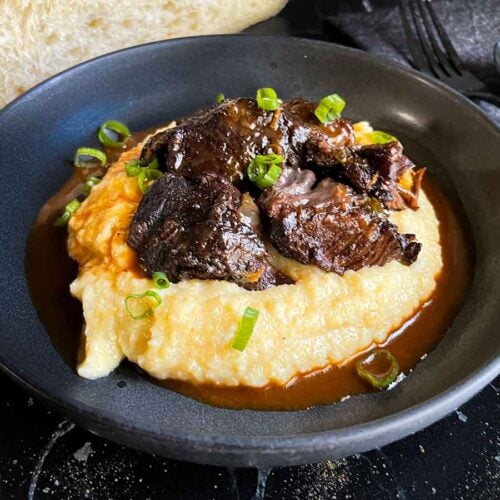
Braised Beef Cheeks
Equipment
- Dutch Oven
- Strainer
Ingredients
- 1 tbsp Olive oil For searing beef cheeks
- 1 tbsp Olive oil For chopped vegetables
- 2 lbs Beef cheek
- 2 Carrots Rough chop
- 2 Celery Rough chop
- 1 Onion Rough chop
- 1 bulb Garlic Halved, lengthways
- 5 sprigs Thyme
- 2 tbsp Tomato paste
- 1 cup Red wine
- 4 cups Beef stock
- Kosher salt
- Black Pepper
Instructions
- Trim any excess fat or connective tissue from the beef cheeks and season well with kosher salt and black pepper.Kosher salt, Black Pepper
- Place dutch oven, or large pot, over medium high heat.
- Add 1 tbsp olive oil.1 tbsp Olive oil
- When heated, add beef cheeks and sear all sides, then remove and set aside.2 lbs Beef cheek
- Add 1 tbsp of olive oil back to the pan.1 tbsp Olive oil
- Add carrots, celery, and onion to the dutch oven and cook for 5 minutes, stirring occasionaly.2 Carrots, 2 Celery, 1 Onion
- Add the garlic and thyme and continue to cook for a minute or so until fragrant.1 bulb Garlic, 5 sprigs Thyme
- Add tomato paste and cook for an additional minute, stirring and coating the vegetables with the tomato paste.2 tbsp Tomato paste
- Add red wine, and cook for about two minutes, cooking out the alcohol.1 cup Red wine
- Add beef stock, and reduce to a simmer.4 cups Beef stock
- Cover with a cartouche and cover pot wiht a lid. Simmer for approximately 2 hours.
- Test meat by tearing it with a spoon. When it's that tender, it's done.
- Remove the beef cheeks, and set aside.
- Strain the remaining juice, discarding the vegetables.
- Serve by plating the beef cheeks and spooning the gravy over it. Serve with your favorite sides.





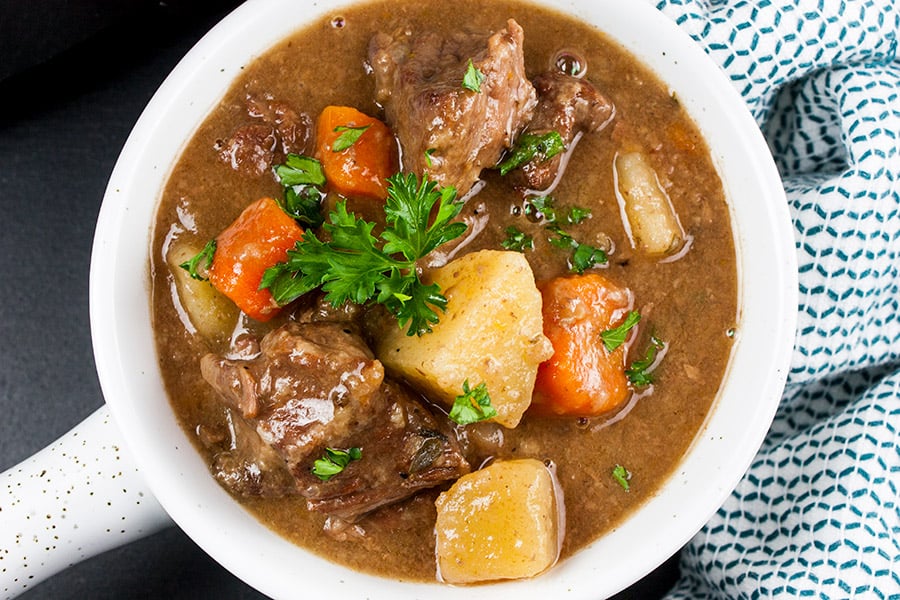
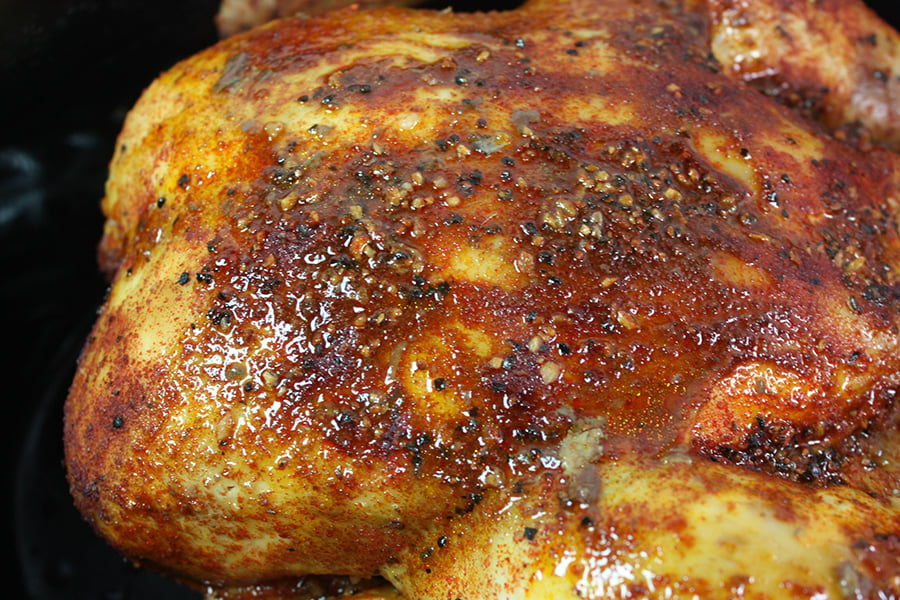
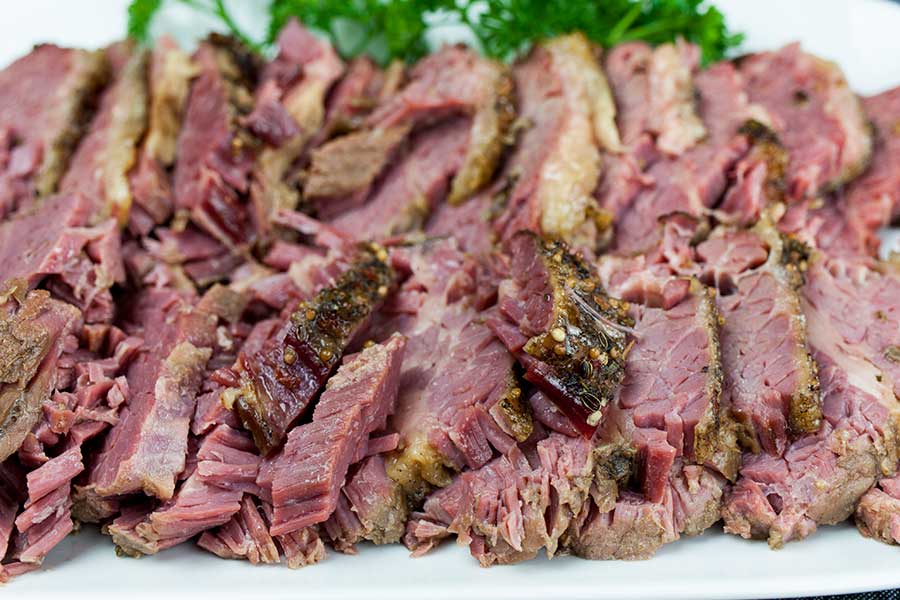
This came out perfectly. Thank you
Awesome, Ashley!! 🙂